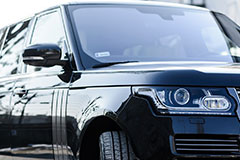Tempered VS Laminated Safety Glass - Vol.360
Whenever you have to choose a safety glass for your car, you have two major options: tempered or laminated. Both are considered to be "safety materials", meaning they must pass all safety regulations and state codes. Each can serve you well under the right circumstances and for the right task, but there are differences that may convince you to choose one over the other.

Tempered Glass
This type of glass is made using a specialized method that involves the sudden heating and cooling of the glass. The sheets must be pre-cut and already edged before the procedure starts, and then the glass is put in a heating furnace, where it is heated up to roughly 1200°F, before being quickly cooled down.
The cooling part is called quenching. Manufacturers usually use cold water to cool the outer layer of the glass while the inner layers remains relatively hot, which makes it approximately four to five times stronger than it would be otherwise.
This type of glass is strong. When damaged, it shatters into small pieces. It doesn't break into large ones that could cut you in case of a serious accident.
The main advantage of tempered glass is its strength, and the fact that it does not break but shatters. It's less likely to cause deep and dangerous cuts than non-tempered glass.
This makes tempered glass an ideal choice for side windows, but not necessarily for windshields. Tempered glass also lets through the harmful UV rays of the sun, so those who travel a lot in sunny places may want to apply extra UV protection. That can be an extra layer on the windows, or sun block on the body.
Laminated Glass
Manufacturers may use more than two glass sheets for the procedure. It all comes down to how the final glass product will be used. Unlike tempered glass, laminated sheets tend to stay together when they are broken, a quality that makes them ideal for windshields. If a bird or some kind of projectile hits the front window, it will not shatter as tempered glass would. Even if it's pierced, the visibility is only compromised in that spot.
Laminated Glass
For laminated glass, manufacturers use a layered approach. It is essentially a sandwich made of glass, with a vinyl layer going in between.
A layer of PVB (polyvinyl butyral) is placed between two glasses, and then sealed. A pressure roller apparatus is used to seal the inner layer in before the whole thing is heated up. The combination of pressure and heat seals the whole thing together.
Manufacturers may use more than two glass sheets for the procedure. It all comes down to how the final glass product will be used. Unlike tempered glass, laminated sheets tend to stay together when they are broken, a quality that makes them ideal for windshields. If a bird or some kind of projectile hits the front window, it will not shatter as tempered glass would. Even if it's pierced, the visibility is only compromised in that spot.
The other key advantage laminated glass has over its tempered counterpart is its ability to block the harmful rays of the sun - 99% of them.
Because of these qualities, laminated glass dominates the windshield industry; the vast majority of front windows are made using this type of glass. There are even multilayered variants that can stop bullets - they are used for bulletproofing cars. These glasses are also considered burglarproof.
Summary
If you want strength and resistance, tempered glass is the right choice. It's ideal for side windows because it's really hard to break, but it doesn't lower your safety - in case of an emergency, it can be broken by applying enough force with a sharp tool or even with the key. And since it will shatter rather than break, tempered glass reduces the disk of cuts and other related injuries.
Laminated glass, on the other hand, can give you the flexibility and UV protection that tempered glass cannot. It's ideal for windshields, especially because it's easy to clean, and highly customizable in terms of colors and material.